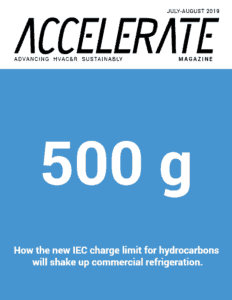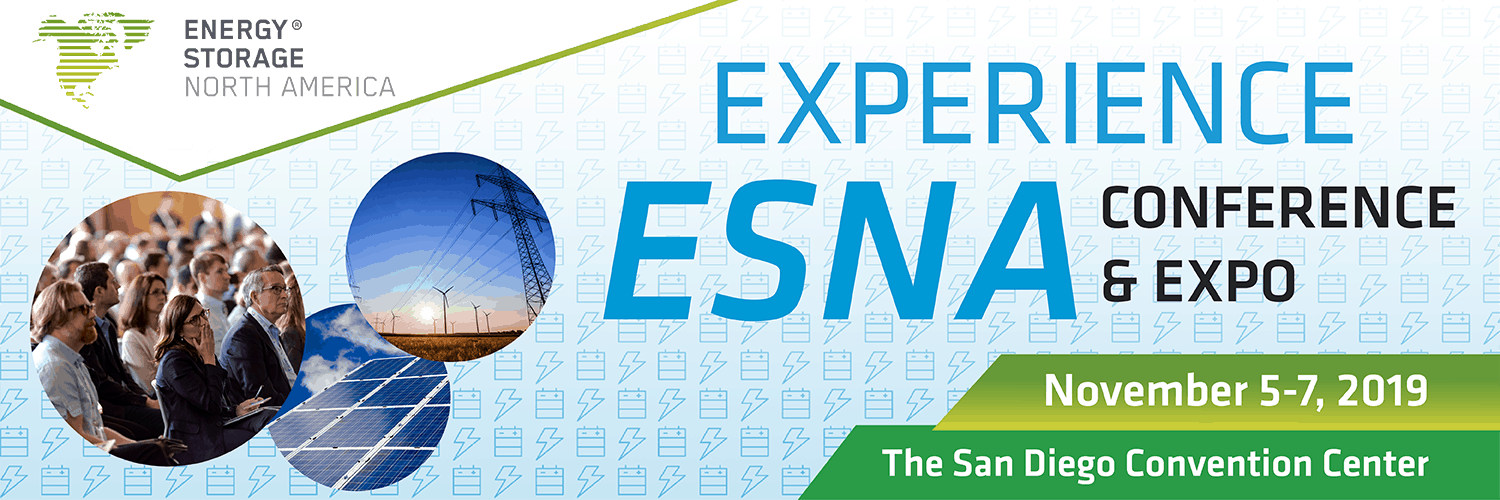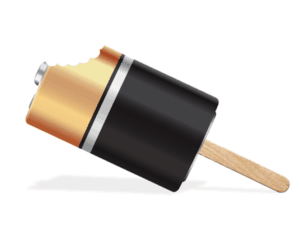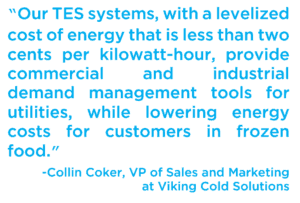Accelerate Magazine

Viking Cold & Eversource Project Selected as Finalist for 2019 ESNA Innovation Award

Viking Cold has been recognized for its deployment of eight Thermal Energy Storage (TES) systems as part of a utility-backed demand management program in Massachusetts. These behind-the-meter TES systems store and facilitate the management of approximately 1.3 MW of energy onsite. This project is noteworthy because Viking Cold’s solution leverages the facilities’ existing refrigeration systems to store cold energy and discharge it over long periods of time (up to 13 hours) when it is most beneficial for the grid and the facility operator, thus lowering energy costs, increasing resiliency, and helping the environment.
The Greater Boston Food Bank, the program’s first installation, has already seen a 75% reduction in energy consumption and a 76% reduction in demand during its four-hour peak demand period.
“As the largest hunger relief organization in New England, our goal is to provide healthy meals to those in need across Eastern Massachusetts,” said The Greater Boston Food Bank SVP of Supply Chain and Food Acquisition, Cheryl Schondek. “We strive for cost-saving operational efficiencies, and our partnership with Eversource and the installation of the Viking Cold TES system better enables us to achieve this goal. We appreciate their commitment to our mission to end hunger here.”
You can read more about the TES project online here.
Please help Viking Cold win this year’s ESNA Innovation Award – you can vote with the form online here. Deadline is September 12, 2019.
FoodDive.com – Using frozen food as a battery to lower energy costs?

Release: Viking Cold Solutions Installs 1.3 MW of Thermal Energy Storage in Industrial Cold Storage Facilities as Part of a Massachusetts Utility Demand Management Program
ENERGY-SAVING THERMAL STORAGE SYSTEMS SUCCESSFULLY DEPLOYED IN WAREHOUSES OWNED BY LOGISTICS COMPANIES, FOODSERVICE DISTRIBUTORS, FOOD PROCESSORS, AND NON-PROFITS
HOUSTON and BOSTON (GLOBE NEWS WIRE) – Viking Cold Solutions, the leading thermal energy storage provider for low-temperature cold storage industries, has completed the installation of eight Thermal Energy Storage (TES) systems as part of a utility-backed demand management program in Massachusetts. These eight behind-the-meter TES systems store and facilitate management of approximately 1.3 megawatts (MW) of energy onsite, and do not require any additional real estate for the system components. The average size of the cold storage facilities in the program is approximately 50,000 square feet, with the largest being 157,000 square feet.

Energy is the second highest direct operating cost for cold storage operators, who must run their refrigeration systems nearly 24 hours per day. Additionally, these facilities have the highest energy demand per cubic foot of any industrial category on the grid. Viking Cold’s TES systems not only store enough energy to cycle off refrigeration for up to 13 hours per day to avoid time-of-use and demand charges, they also improve the existing refrigeration systems’ efficiency and reduce consumption by more than 25 percent.
Read More →
Food Logistics – Should Frozen Food Be a Battery?
The May 2019 edition of Food Logistics includes an article outlining the risks of using frozen food as a battery for flywheeling. The article also discusses using Viking Cold’s Thermal Energy Storage systems as an alternative temperature capacitor to achieve even better flywheeling results, reduce the risks of flywheeling, and provide additional benefits. Utility-sponsored programs that can subsidize or entirely cover the system and installation costs are also discussed.
Energy Central – PLMA Technology Pioneer Award Interview

Engineered Systems – The Blueprint: Q&A interview with HVACR engineering’s leading voices

PLMA recognized Viking Cold as a 2019 Technology Pioneer

Grocery Business – Are You Meeting Scope 1, 2, and 3 Emissions Goals Like Your Competitors?
An article on the Grocery Business website describes the importance of understanding multiple categories of sustainability standards and why each Scope 1, Scope 2, and Scope 3 emissions goals are important for grocers to remain competitive. Learn more about the expectations of customers, competitors, investors, and even CPG brands for grocers to improve their sustainability.
GreenTech Media recognizes the successes and enormous opportunities for thermal energy storage


